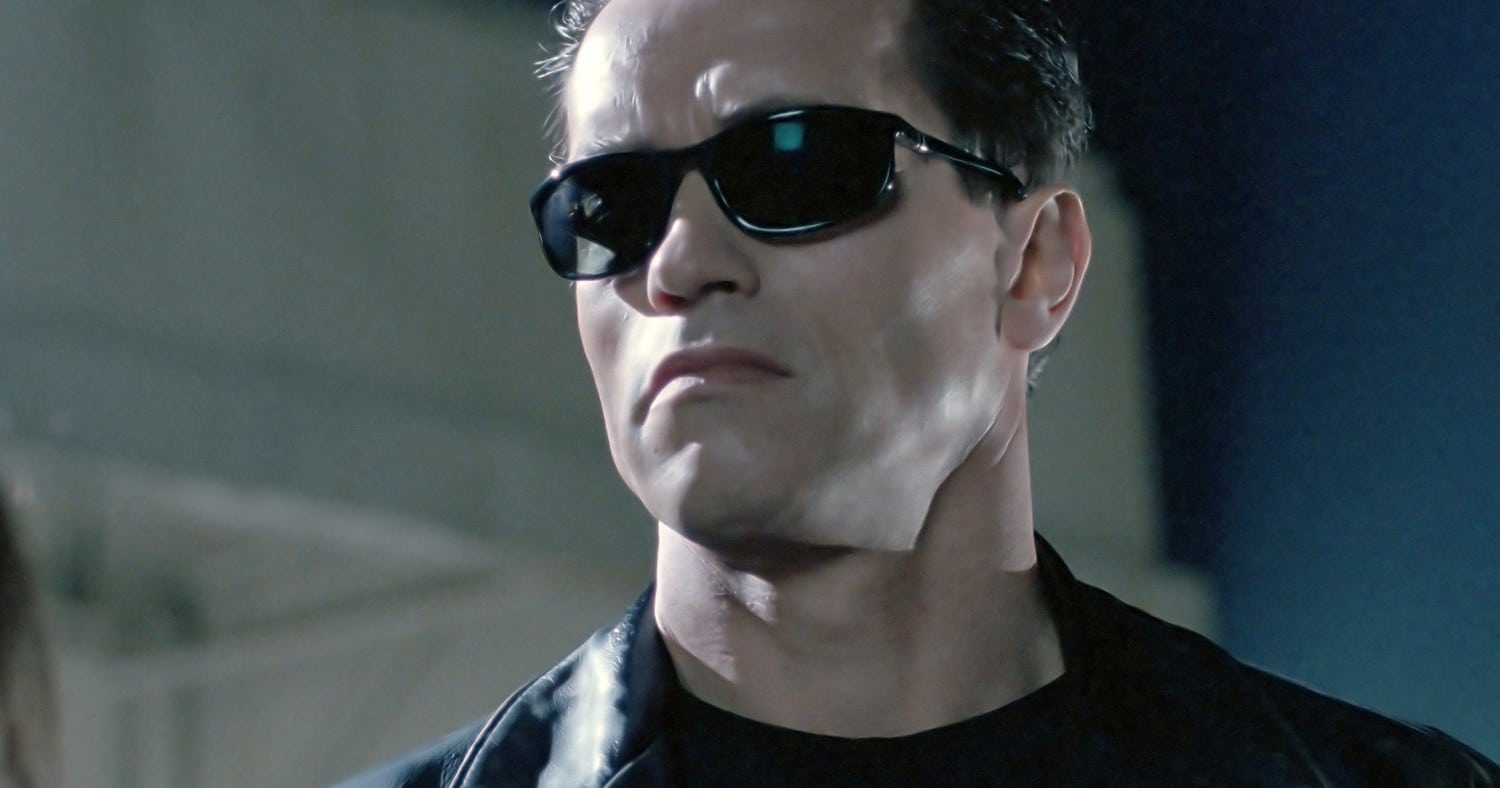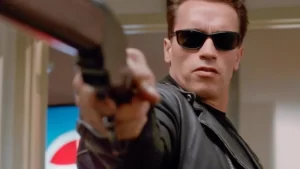Terminator 2: Judgement Day has been named as entering the National Film Registry for 2023 which also includes A Nightmare Before Christmas, Apollo 13, Home Alone, and more.
The news includes that twenty-five influential films have been selected for the 2023 Library of Congress National Film Registry, Librarian of Congress Carla Hayden announced today. The films are selected each year for their cultural, historic or aesthetic importance to preserve the nation’s film heritage.
The newest selections include a diverse group of films, filmmakers and Hollywood landmarks exploring the drama of history, social justice and reform, the experiences of immigrants and more. This year’s selections date back more than 100 years to a 1921 Kodak educational film titled “A Movie Trip Through Filmland” about how film stock is produced and the impact of movies globally. The most recent films added to the registry are 2013’s Oscar-winning “12 Years a Slave” and the Oscar-winning documentary “20 Feet from Stardom.”
Some Hollywood releases selected this year include the space drama “Apollo 13,” the holiday classic “Home Alone,” Disney’s 1955 beloved animation “Lady and the Tramp,” the sci-fi sequel “Terminator 2: Judgment Day,” and the Halloween and holiday favorite “The Nightmare Before Christmas.” Plus, there’s the selection of “Love & Basketball,” which has grown new audiences over the years as an inspiring classic love story.
The selections bring the number of films in the registry to 875. Some of these films are among the 2 million moving image collection items held in the Library. Others are preserved by the copyright holders or other film archives.
“Films are an integral piece of America’s cultural heritage, reflecting stories of our nation for more than 125 years. We are proud to add 25 diverse films to the National Film Registry as we preserve our history through film,” said Librarian of Congress Carla Hayden. “We’re grateful to the film community for collaborating with the Library of Congress in our goal to preserve the heritage of cinema for generations to come.”
Turner Classic Movies (TCM) will host a television special Thursday, Dec. 14, starting at 8 p.m. ET to screen a selection of films named to the registry this year. Hayden will join TCM host, film historian and Academy Museum of Motion Pictures Director and President Jacqueline Stewart, who is chair of the National Film Preservation Board, to discuss the films.
Stewart said this year’s selections highlight the “breadth of experiences in American culture, in American history.”
“I’m delighted to see several films this year that recognize a diversity of Asian American experiences,” she said. “There’s ‘Cruisin’ J-Town,’ a film about jazz musicians in Los Angeles’ Little Tokyo community, specifically the band Hiroshima. There’s also the Bohulano Family Film collection, home movies from the 1950s-1970s shot by a family in Stockton, California’s Filipino community. Also added is the documentary, ‘Maya Lin: A Strong, Clear Vision,’ about one of our most important contemporary artists who designed the Vietnam Veterans Memorial in Washington, D.C.”
The Library plans to screen two newly selected holiday films for audiences at Live! at the Library in December, including “The Nightmare Before Christmas” on Dec. 21 at 6:30 p.m. and “Home Alone” on Dec. 28 at 6:30 p.m. Free timed-entry passes are available at loc.gov/visit.
Select titles from 35 years of the National Film Registry are also freely available online in the National Screening Room.
Films Selected for the 2023 National Film Registry
(chronological order)
- A Movie Trip Through Filmland (1921)
- Dinner at Eight (1933)
- Bohulano Family Film Collection (1950s-1970s)
- Helen Keller: In Her Story (1954)
- Lady and the Tramp (1955)
- Edge of the City (1957)
- We’re Alive (1974)
- Cruisin’ J-Town (1975)
- ¡Alambrista! (1977)
- Passing Through (1977)
- Fame (1980)
- Desperately Seeking Susan (1985)
- The Lighted Field (1987)
- Matewan (1987)
- Home Alone (1990)
- Queen of Diamonds (1991)
- Terminator 2: Judgment Day (1991)
- The Nightmare Before Christmas (1993)
- The Wedding Banquet (1993)
- Maya Lin: A Strong Clear Vision (1994)
- Apollo 13 (1995)
- Bamboozled (2000)
- Love & Basketball (2000)
- 12 Years a Slave (2013)
- 20 Feet from Stardom (2013)
Public Nominations for the National Film Registry
The public submitted 6,875 titles for consideration this year. Several titles selected this year drew significant support, including “Home Alone” and “Terminator 2: Judgment Day.”
The public can submit nominations throughout the year on the Library’s web site Nominations for next year will be accepted until Aug. 15, 2024. Cast your vote at loc.gov/film.
Ron Howard Reflects on “Apollo 13”
Since his first childhood role as Opie on “The Andy Griffith Show,” to his later acting in “Happy Days” and “American Graffiti,” Ron Howard has been associated with mid-century American innocence.
In “Apollo 13,” he returned to that ideal as a director, telling the story of a 1970 failed lunar landing that turned into a heart-stopping triumph of American ingenuity in bringing the crew safely back to Earth.
“It’s a very honest, heartfelt reflection of something that was very American, which was the space program in that time and what it meant to the country and to the world,” Howard told the Library of Congress.
The technical advisor on the film was Capt. David Scott, an astronaut who went to the moon. He gave Howard a mission statement.
“He said you have a chance to tell people what it was like within the framework of a narrative that is entertaining. You have the chance to really get it right and let people know what the Apollo era was all about. We took that very seriously,” Howard said.
The crew was fanatical about getting small details right, an effort led by the film’s star, Tom Hanks.
“I was very proud of the outcome,” Howard said. “The experience remains an absolute highlight. It was one of those experiences that none of us involved in will ever forget.”
Gina Prince-Bythewood Talks “Love & Basketball”
Gina Prince-Bythewood’s breakout hit in 2000, “Love & Basketball,” was an intensely personal project that took years to bring to life. It was her feature film directorial debut. She grew up in Pacific Grove, California, and was a high-school basketball and track star. She ran track while in college at UCLA.
“A great deal of this film was autobiographical,” she said in an interview. “Monica’s character, growing up as an athlete, all the feelings she felt, feeling ‘othered’ and different as if something’s wrong with her because she loves sports. All those were things that I had to deal with growing up, being a female athlete and with my parents.”
In high school, her career goal was to write for soap operas. She went to UCLA’s prestigious film school and then wrote for television after graduation. She longed to write a Black version of the romantic comedy “When Harry Met Sally.” But after working in the film business, she wasn’t optimistic.
“I was really discouraged that there weren’t Black love stories,” she said. “And so I wanted to see myself in a love story.”
She quit her lucrative television job to work on the script for more than a year. It became the culmination of both of her loves.
“It’s a love story set in a basketball world,” she said.
The film was a commercial and critical success, becoming a rom-com standard.
“It’s incredibly humbling. It absolutely set the tone for my career…it told the industry who I was as a filmmaker, and that film has led to every film after that,” Prince-Bythewood said. “It’s a beautiful thing.”
Steve McQueen: A Decade After “12 Years a Slave”
Steve McQueen, director of the Academy Award-winning “12 Years a Slave,” said he was attracted to the story of the film’s real-life protagonist, Solomon Northup, because he saw him as a hero.
The film, which won Best Picture in 2013, is based on Northup’s memoir of the same name. It recounted how he was kidnapped in Washington, D.C., and then put on the auction block. He eventually won his freedom — friends in the North located him after a decade and pursued his case through the courts — and began a new life as a fierce abolitionist.
“Solomon Northup is an American hero,” McQueen said.
On why he took on such difficult subject matter:
“Slavery for me was a subject matter that hadn’t been given enough recognition within the narrative of cinema history,” he said. “I wanted to address it for that reason, but also because it was a subject which had so much to do with how we live now. It wasn’t just something which was dated. It was something which is living and breathing, because you see the evidence of slavery today.”
The film was shot in just 35 days. McQueen stressed rehearsals and preparation.The movie was a success worldwide, defying expectations that there was little to no market for such a story.
“Solomon Northup, his family today is Black, it’s white, it’s tall, it’s thin, it’s round, it’s all colors, it’s all of America,” McQueen said. “It’s incredible.”
Ang Lee Recalls “The Wedding Banquet”
Oscar-winning director Ang Lee said his second film, “The Wedding Banquet,” a 1993 romantic comedy, reminded him today of his youthful passion for filmmaking. The film, about a gay man trying to keep his Taiwanese family happy but ignorant about his life in America, was a modern twist on a familiar tale of family traditions clashing with new generations.
“I didn’t make the movie to be influential, but it was,” Lee said in an interview. “I see since the movie, whether it’s cross-culture or gay issues, some major breakthroughs, certainly in Taiwan and the Chinese community because the movie was well-liked. It just eased into people’s lives quite naturally.”
He based the story partly on his own wedding experience in New York City — a quick ceremony in court, at which his mother cried — and on the story of a Chinese friend who was gay but staged a wedding to a Chinese woman to conceal the relationship from his conservative parents back in China.
The centerpiece of the story, an over-the-top wedding banquet, is a part of Chinese society that fascinated him.
“Chinese are really conservative, reserved people, but the wedding banquets are totally outrageous,” he said. “Wedding banquets are so rowdy, so out of line. It makes for great comedy and great drama.”
Spike Lee: Showing His Truth in “Bamboozled”
Spike Lee’s “Bamboozled” is a 2000 satire of blackface in cinema, in which a show designed to be an offensive bomb with Black actors in black face instead becomes a hit. It got mixed reviews from critics and was not a commercial hit.
Lee said three movies greatly influenced the production. “Birth of a Nation,” the racist but influential 1915 film that used blackface and helped ignite the rebirth of the Ku Klux Klan; “A Face in the Crowd,” a 1957 movie about the rise of power-hungry media personality; and 1967s “The Producers,” from which he borrowed the main plot device.
“One of the most powerful sequences I think I’ve done is the closing scenes of ‘Bamboozled,” where we show historically, visually, the hatefulness of white people in blackface. Judy Garland, Mickey Rooney, Eddie Cantor…just the debasement of who we are as a people,” Lee said.
He remembered the lack of context or insight his film school professors had for the racist content of the film.
“When they screened ‘Birth of a Nation’ at NYU film grad school, all they talked about was the great techniques or that D.W. Griffith was called the father of cinema. But they never talked about the fact that this film gave new life to the Klan,” he said.
“Bamboozled” drew many negative reviews for its dark tone and subject matter, but Lee said he was not overly concerned with audience reaction.
“It’s my fourth decade of filmmaking, and I don’t remember saying to myself, ‘Don’t do this because the audience might not like it,’” he said. “And there were more cases where audiences did not like stuff but that did not matter to me because I was showing the truth as I see it.”
Film Scholar Considers “¡Alambrista!”
“¡Alambrista!” is an immigrant story, shot in a documentary style, often with a shaky handheld camera that wanders between and around actors, about a farmer in Mexico who comes to the U.S. as an undocumented worker in order to support his family. It was a small-budget film in 1977 that broke new ground.
To assess the film’s historical significance, the Library turned to Chon Noriega, a professor of cinema and media studies at UCLA who focuses on Latino film studies, particularly films of Mexicans and Mexican Americans.
Noriega said the film, by first-time feature director Robert Young, took elements of guerilla and activist filmmaking into its approach, making it an original and unusual look at its subject.
“The film offers a very different view of the United States, and it’s not one that’s based on analysis or critique or politics. It’s based on observation,” Noriega said. “And what you see in this film is what the United States looks like from the point of view of a migrant worker.”
“There’s a lot to take into account in this film. It really breaks new ground,” Noriega said. “And there’s really, as far as I can tell, nothing like “¡Alambrista!” that puts migrant labor on the table in a fundamentally different way.”
Freida Lee Mock and the Story of Maya Lin
Freida Lee Mock won the 1994 Academy Award for Best Documentary feature for “Maya Lin: A Strong, Clear Vision” about the artist who is most famous for creating the Vietnam Veterans Memorial in Washington, D.C., and the Civil Rights Memorial in Montgomery, Alabama.
“Maya, her work and the film — it has a national resonance and is an important part of who we are as Americans,” Mock said.
She first heard of Lin in 1981, sitting in her mother’s kitchen reading a newspaper article about the controversial design for the proposed D.C. memorial and the architectural student at Yale University who had won a national competition for the project.
“I saw the name Maya Lin and because it was an Asian American name, it caught my eye since I, too, am Asian American,” Mock said. “I was stunned by her comments to critics of her design and how she was precise and quite ironically funny.”
Mock was intrigued with making a film about two big ideas: war and race. After gaining Lin’s agreement to cooperate on the project, she thought it would take a year. It took five, involving multiple cross-country trips. The capstone was the 10th anniversary ceremony of the Vietnam Memorial in 1992 on a rainy day in D.C., which provides the emotional coda to the film.
“It was a hallelujah moment, you might say, for the film to have that kind of culmination, a dramatic end. I was so pleased,” Mock said. “It was a beautiful, beautiful 10th anniversary with all the people who were intimates to the creation of that piece.”
The 2023 National Film Registry
(alphabetical order)
¡Alambrista! (1977)
“¡Alambrista!” is the powerfully emotional story of Roberto, a Mexican national working as a migrant laborer in the United States to send money back to his wife and newborn. Director Robert M. Young’s sensitive screenplay refuses to indulge in simplistic pieties, presenting us with a world in which exploitation and compassion coexist in equal measure. The film immerses us in Roberto’s world as he moves across vast landscapes, meeting people he can’t be sure are friend or threat, staying one step ahead of immigration officials. “¡Alambrista!” is as relevant today as it was on its 1977 release, a testament to its enduring humanity. In an essay for its Criterion DVD release, film scholar Charles Ramirez Berg called “¡Alambrista!” the “first and arguably best rendering of the Mexican American diaspora story.”
Apollo 13 (1995)
The extreme challenges involved in space travel present compelling cinema storylines, and one cannot imagine a more harrowing scenario than the near tragic Apollo 13 space mission. Director Ron Howard’s retelling is equally meticulous and emotional, a master class in enveloping the audience into a complicated technological exercise in life-and-death problem-solving. Based on the 1994 book “Lost Moon: The Perilous Voyage of Apollo 13” by astronaut Jim Lovell and Jeffrey Kluger, “Apollo 13” blends skillful editing, crafty special effects, a James Horner score, and a well-paced script to detail the quick-thinking heroics of both the astronaut crew and NASA technicians as they improvise and work through unprecedented situations. The talented cast includes Tom Hanks, Bill Paxton, Kevin Bacon, Gary Sinise, Ed Harris and Kathleen Quinlan.
Bamboozled (2000)
Mixing elements of “A Face in the Crowd,” “The Producers,” “Network” and “Putney Swope,” Spike Lee’s “Bamboozled” showcases his unique talents, here blending dark comedy and satire exposing hypocrisy. An African American TV executive (Damon Wayans) grows tired of his ideas being rejected by his insincere white boss, who touts himself with an “I am Black People” type of vibe. To get out of this untenable situation, Wayans proposes an idea he feels will surely get him fired: a racist minstrel show featuring African American performers donning blackface. The show becomes a smash hit while at the same time sparking outrage, including militant groups leading to violence. As with the best satire, the focus is not on believable plot but rather how the story reveals the ills of society, in this case how Hollywood and television have mistreated African Americans over the decades.
Bohulano Family Film Collection (1950s-1970s)
Delfin Paderes Bohulano and Concepcion Moreno Bohulano recorded their family life for more than 20 years. Shot primarily in Stockton, California, their collection documents the history of the Filipino community during a period of significant immigration. They were involved in the local Filipino American community, including the building of Stockton’s new Filipino Center in the early 1970s. The movies record community events, family gatherings, trips to New York City, Atlantic City, and Washington, D.C., as well as the family’s 1967 visit to the Philippines. Preserved by the Center for Asian American Media.
Cruisin’ J-Town (1975)
Duane Kubo’s documentary tells the story of the jazz fusion band Hiroshima, including their attempts to blend art and identity, the group’s roots and influence in the Little Tokyo section of Los Angeles, and the burgeoning pulse of the Asian American and Pacific Islander community in the early 1970s. A highlight in the film is a cross-cultural jam with Hiroshima and the Chicano performing arts company El Teatro Campesino. Preserved by the Academy Film Archive in collaboration with Visual Communications.
Desperately Seeking Susan (1985)
As a follow-up to her acclaimed low-budget indie “Smithereens,” Susan Seidelman directed this hip screwball romp involving personal ads, mistaken identity and only-in-New-York characters. The film features Rosanna Arquette as an unhappy New Jersey housewife and Madonna as a Lower East Side bohemian free spirit named Susan; Arquette’s deep immersion into Susan’s strange world helps Arquette recharge her life and cure its ills. As critics noted, the wacky plot serves as adventure thriller therapy for Arquette as she careens from one unlikely bizarre event to another. The film also shines as a historical snapshot, offering vignettes into parts of New York City that no longer exist, as well as glimpses into 80s fashion and music, especially Madonna’s personal style and her renowned dance single “Into the Groove.”
Dinner at Eight (1933)
Director George Cukor has many works on the National Film Registry and the racy, pre-Code comedy/drama “Dinner at Eight” illustrates why. Cukor knew how to adapt plays into film, removing their staginess to make them work well on film and adding wit. Cukor also was a master on how best to use the strengths of his actors and handle egos. This ensemble film about high society features an all-star cast, arguably one of the greatest assembled to that point in cinema history, and it became a major attraction and event in the early sound era. Frances Marion and Herman J. Mankiewicz adapted the George S. Kaufman and Edna Ferber play for the screen.
Edge of the City (1957)
“Edge of the City” features superb performances by John Cassavetes and Sidney Poitier in a psychological drama set among New York City railroad workers. Based on a live television drama written expressly for Poitier by Robert Alan Aurthur, “Edge of the City” follows Cassavetes as a troubled Army deserter who finds trust in others, maturity in himself, and reintegration into society after Poitier, playing a stevedore foreman, befriends him. Praised by the NAACP for its message of racial brotherhood, this first feature of blacklisted television director Martin Ritt offers finely delineated performances by Ruby Dee, Kathleen Maguire and Jack Warden. Critic Stanley Crouch called the film “one of the highest of the high points in Poitier’s career,” noting “an almost heartbreaking effect in his absolute freedom from the stereotypic, moving with such vitality through so many more moods than would be expected of a Black character then or now.”
Fame (1980)
Alan Parker’s teen musical drama follows the lives of students at New York City’s High School of the Performing Arts as they tackle the demanding environment and the issues young students face. The musical numbers stylistically often resemble music videos in a pre-MTV world, and “Fame” influenced other classic 80’s musicals like “Footloose,” “Flashdance” and “Dirty Dancing.” Irene Cara belts out the rousing title song. Film critic Roger Ebert said “‘Fame’ is a genuine treasure, moving and entertaining, a movie that understands being a teen-ager…” The 1980s produced many classic movies on teen life, and “Fame” was a worthy prelude of great films to come.
Helen Keller in Her Story (1954)
Nancy Hamilton’s Academy Award-winning documentary tells the story of Helen Keller from her birth to early 70s. Keller lived for 14 more years after the film. The documentary came about long after Keller became an international speaker on behalf of both disabled rights and the United States. It uses news footage, photographs, interviews and original sequences to tell her story, as well as a more day-in-the-life approach. Preserved by the Academy Film Archive.
Home Alone (1990)
The young and deeply expressive Macaulay Culkin became a superstar thanks to this 1990 mega-hit that has become embedded into American culture as a holiday classic. Left home alone at Christmas time, a plucky youngster uses his creativity and wit to stave off two bumbling burglars. John Hughes (at that time best known for his teen comedies) fashioned the inventive script while Chris Columbus directed the film for maximum cross-generational appeal. The cast also includes Daniel Stern, Joe Pesci, John Heard, Roberts Blossom and Catherine O’Hara. Composer John Williams contributes a memorable score, including the classic “Somewhere in My Memory.”
Lady and the Tramp (1955)
This exquisitely animated love story between a spoiled cocker spaniel and a mutt was arguably the most mature animation and love story created until then by Disney Studios. It also marked a technological innovation for Disney. In addition to standard theatrical formats, Disney released the film in the wide screen CinemaScope process, in part to keep people going to the theaters following the advent of television. One of the studio’s most beloved animated works, this unlikely love story is made memorable by endearing songs, excellent voice talents (which included Barbara Luddy, Larry Roberts, Bill Thompson, Verna Felton, Bob Baucom, Peggy Lee and Stan Freberg) and iconic moments including a kiss involving spaghetti.
The Lighted Field (1987)
“The Lighted Field” is one of the avant-garde masterworks from Andrew Noren.“I’m a light thief and a shadow bandit,” Noren (1943 – 2015) once said. “The lovers, light and shadow, and their offspring space and time are my themes, working with their particularities is my passion and delight.” “The Lighted Field” (1987, 62 mins, silent, B&W, 16mm) is a highly personal work in which Noren uses archival imagery combined with urban and domestic images that are infused with his love of light play and evoke a twinned sense of vitality and mortality.
Love & Basketball (2000)
For her feature film directorial debut, Gina Prince-Bythewood wrote and directed the engaging “Love and Basketball,” which follows a boy and girl as they pursue their basketball careers from childhood to adults, sharing a mutual affection for the game and an eventual love for each other. Unforgettable and inspiring, the film has been praised as a refreshing new take on the rom-com genre and has had an enduring impact and ongoing resonance with women athletes and young people. Spike Lee served as one of the producers.
Matewan (1987)
Bringing to light a little-remembered moment in labor history, John Sayles’ “Matewan” dramatizes efforts in 1920 to unionize a West Virginia company town and the bloody battle that followed between strikers and coal company thugs. Sayles incorporates elements from related labor struggles into the story to show how Black migrants and European immigrants hired as scabs often united with local miners. Structured as a Western, the film examines collective nonviolence as a strategy to combat ruthless exploitation within an individualistic culture animated by blood feuds. “‘Matewan’ offers a meditation on broad philosophical questions rarely confronted directly in American films,” historian Eric Foner has written. Expertly filmed by Haskell Wexler and featuring engaging ensemble acting by Chris Cooper, James Earl Jones, Mary McDonnell, David Strathairn, Will Oldham and many West Virginia locals, this low-budget gem illuminates remote Appalachian cultural attitudes at a turning point in labor union history. Photochemically preserved by the UCLA Film & Television Archive in collaboration with Anarchists’ Convention. Laboratory services by Monaco Labs/Video/Digital. Sound services by Audio Mechanics, DJ Audio. Digital restoration work by Criterion. Special thanks to Suzanne Ceresko, Maggie Renzi, Scott Smerdon, John Sayles.
Maya Lin: A Strong Clear Vision (1994)
Freida Lee Mock’s Oscar-winning documentary tells the story of Chinese American artist and architect Maya Lin. As a Yale University student, Lin won a nationwide design competition to create the new Vietnam Veterans Memorial on the National Mall. A firestorm of controversy erupted over the selection of Lin’s design, with critics citing her age, lack of architectural experience, her Asian American ancestry, the design’s black granite, and what they saw as something overly bleak, buried in the ground, rather than a heroic tribute. Lin eloquently defended herself, and the stark, simple elegant beauty of her V-shaped design pointing toward the Lincoln Memorial and Washington Monument won the day. The highly visited site has become a cathartic, emotional experience for countless Americans. The film explores themes about artistic freedom, creativity, public art and politics.
A Movie Trip Through Filmland (1921)
This educational and highly informative film about the production of motion picture film stock and the impact of movies on a global audience was shot at Kodak Park, the headquarters of the Eastman Kodak Company in Rochester, New York. The film begins with a gathering of animated multi-national characters as they attend the “International Convention of Movie Fans.” The animated curtains part, and the audience sees Kodak Park and a short movie detailing every step of the film manufacturing process, including statistics on how much raw cotton, silver and water is used to create the 147,000 miles of film stock produced in 1921 (enough to circle the globe). Preserved by the George Eastman Museum in 2005 from two tinted and toned diacetate prints in collaboration with the Eastman Kodak laboratory in Rochester, funded by Eastman Kodak Company.
The Nightmare Before Christmas (1993)
The king of dark whimsy, Tim Burton won over an even larger (and decidedly younger) crowd with this delightful stop-motion animated offering. Jack Skellington, whose giant pumpkin head rests precariously on top of his rail-thin body, is the king of Halloween Town; one year he dreams of bringing a little Christmas magic to his humble hamlet. Conceived and produced by Burton (with direction by Henry Selick), “Nightmare” features creative set design to construct an imaginary world, songs by Danny Elfman and the voice talents of Chris Sarandon, Catherine O’Hara, William Hickey, Ken Page, Paul Reubens and Glenn Shadix. It has become both a Yuletide and Halloween tradition for adults, kids, hipsters and many Halloween fanatics.
Passing Through (1977)
A key figure in the LA Rebellion film movement, director Larry Clark uses “Passing Through” as a rumination on the central importance of jazz in African American culture and the attempts of others to appropriate this legacy for profit. Released from prison, an African American jazz artist refuses to rejoin the music industry he feels is controlled by white mobsters and corporate interests. Instead, he seeks to find his grandfather and musician mentor in order to preserve his artistic integrity and rediscover the creative and social possibilities of jazz. In a 2023 interview with the British Film Institute, Clark said: “Jazz is the sum total of the Black American experience. It is an expression of our history here in the United States.” Rarely seen but of seminal importance, “Passing Through” ranks near the top of the greatest jazz films. Screenplay by Clark and Ted Lange. Music by Horace Tapscott. Preserved by the UCLA Film & Television Archive as part of its initiative LA Rebellion: Creating a New Black Cinema. Special Thanks to Larry Clark.
Queen of Diamonds (1991)
This landmark work by experimental filmmaker Nina Menkes was filmed on location in Las Vegas. Menkes’ sister and collaborator, Tinka Menkes, plays an alienated blackjack dealer living and working in Sin City. The film takes a close look at the desolation of daytime Vegas, contrasting the lights, noise and life of the city to the quiet, lonely reality of its residents. Nina expresses her unique style through the use of long takes and extended periods of silence to convey her character’s solitary life in the Nevada desert. Restored by the Academy Film Archive and The Film Foundation with funding provided by the George Lucas Family Foundation.
Terminator 2: Judgment Day (1991)
Science fiction film sequels sometimes fail because the original reveals the stunning main secrets, thus reducing the awe and surprise factors in future installments. Not so with “Terminator 2.” Director James Cameron retained the many virtues of the original and added a deft script with more nuanced characters and plot twists, a large budget and cutting-edge special effects for an even more chilling story revealing the bleak future portended in the original. Arnold Schwarzenegger’s mission changes from ending the future of humanity to ensuring its survival, from killing the mother to protecting the son from an assassin adept at quicksilver. The film also marked somewhat of a technical milestone in the transition from practical to CGI special effects.
12 Years a Slave (2013)
One of the key films of the 2000s and winner of the Best Picture Oscar, “12 Years a Slave” offers a raw, visceral look at slavery on a Louisiana plantation. Directed by Steve McQueen, the film is based on the 1853 memoir of the same name by Solomon Northup, an African American free man who was kidnapped and sold into slavery for 12 years before regaining his freedom. In addition to the Best Picture Oscar, the film also won for Best Adapted Screenplay (John Ridley), and Best Supporting Actress (Lupita Nyong’o). Bill Pohlad’s River Road and Plan B, Brad Pitt’s company, produced the film.
20 Feet from Stardom (2013)
Morgan Neville directed this fascinating, Oscar-winning documentary on back-up singers, the unsung musical workhorse heroes who provide musical harmony and essential contributions to famous songs while lurking in the shadows. The film features interviews with prominent back-up singers such as Darlene Love, Merry Clayton, Lisa Fischer, and Judith Hill. interspersed with archival footage from artists such as David Bowie.
The Wedding Banquet (1993)
A ground-breaking romantic comedy, Ang Lee’s second film focuses on the cultural clashes between East and West, traditional vs. modern lifestyles. To satisfy his parents back in Taiwan and their desire that he get married, a gay Taiwanese American immigrant in New York has a marriage of convenience with a mainland Chinese woman. Complications ensue when the parents decide to visit and meet the bride. The unconventional family trio (gay couple/paper wife) works to create a believable façade. Both hilarious and poignant, the film glides effortlessly between various genres. In a 1993 Los Angeles Times interview, Lee said he wanted the film to be both funny and provocative: “I love stirring things up rather than sticking to the Chinese ideal, which is to appeal for calm.”
We’re Alive (1974)
In 1974, three female UCLA graduate students, Michie Gleason, Christine Lesiak and Kathy Levitt, led a video workshop at the California Institution for Women, then the largest women’s prison in the U.S. What emerged from six months of roundtable discussions — taped by the incarcerated participants — is “We’re Alive,” a 49-minute documentary of astonishing power. Simultaneously anonymous and intimate, the women are unsparing in their condemnation of the dehumanization of the carceral state while at the same time exemplifying a triumphal dignity (alive, indeed). The film is a blueprint for prison reform and thus, unfortunately, as timely today as it was then. Digitally restored by the UCLA Film & Television Archive. Funding provided by the Columbia Motion Picture Research Fund. Laboratory services by illuminate Hollywood, UCLA Film & Television Archive, Endpoint Audio Labs. Special thanks to UCLA Women’s Collective, Michie Gleason, Kathy Levitt, Chris Mohanna Lesiak, and the British Film Institute.







